By Emily Stimpson Chapman
Emily Stimpson Chapman is the award-winning author of several books, including The Catholic Table: Finding Joy Where Food and Faith Meet. Find more recipes on her blog, The Catholic Table.
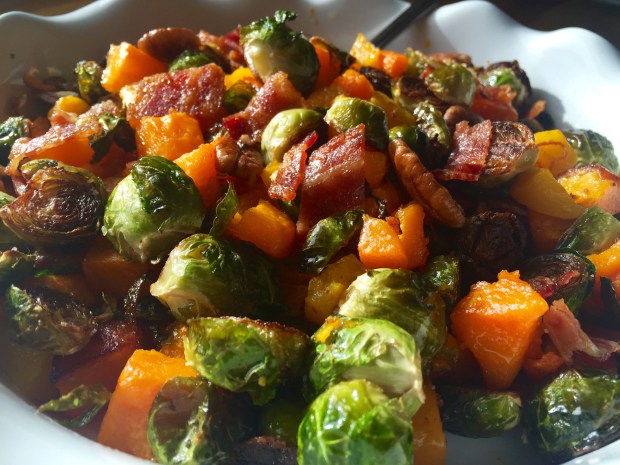
For years, mostly because of the hassle of traveling 1280 miles, roundtrip, on Thanksgiving weekend, I stayed in Steubenville for the holiday and opened my home to whomever didn’t have one that day. One year, that number was as large as 25. Another year, it was as small as four.
A few special friends, however, have always been around the table, and those are the ones less than pleased when Chris and I go to my parents for Thanksgiving.
I’m looking forward to being with all my nieces and nephews next week, but I have to admit, I’m a little sad too. There’s no holiday I like better than Thanksgiving, and (in all humility) there’s also no meal I cook better than Thanksgiving Dinner. People have flown across the country for my mashed potatoes and stuffing. Some of those people also are under the impression that my gravy is a beverage. (“Just because something has brandy in it,” I tell them, “doesn’t mean you can drink it.” They never listen.)
It’s not only the company or food that makes Thanksgiving special for me, though. It’s also the chance to pull out all the decorating stops and set the most elegant table I can muster. In grad school, that wasn’t much. But here’s what we've done in the past.
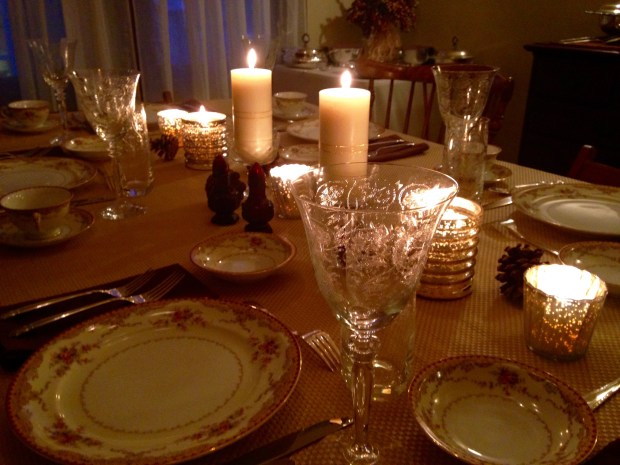
Family, however, comes before fancy china, so all that prettiness will have to stay tucked away until next year. Besides, I’ll still get to do a fair bit of cooking at home, and there will be exceptionally cute children around the table this Thanksgiving…something which last year’s dinner was sorely (and unusually) lacking.
Regardless, before I head off for Illinois, I figured it couldn’t hurt to share a secret or two with you folks. So, for your eating pleasure, here are three staples of my Thanksgiving table: Creamy Garlic Whipped Potatoes, Roasted Winter Vegetables, and Stir-fried Kale and Bacon.
For those who need to concern themselves with such things, all are gluten-free, and two are Paleo-friendly. They’re also incredibly tasty. Lunches this past week (as I’ve made and photographed the recipes) have been affairs to remember!
(Oh, and one last thing. Maybe, if certain people are reading this, they can just cook the recipes themselves and be less grumpy with me.)
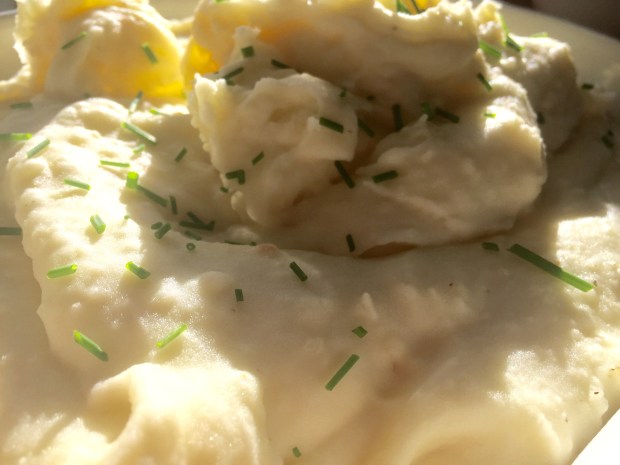
Garlic Mashed Potatoes
Serves:8
Prep Time: 20 minutes
Cook Time: 40 minutes
Notes: These are very special potatoes (repeat: very special potatoes), made on very special occasions. Accordingly, none of the fat or calories count. So, don’t even let yourself think about it when making these. Add dairy fat with abandon, and give praise to God for the cow. Also, save yourself some stress and make these on Thanksgiving morning, several hours before you eat. Then, keep them warm in a crockpot (set on low) until dinner time, stirring occasionally to prevent browning (I usually leave mine in there for about 4 hours).
Ingredients
- Idaho potatoes, 5 pounds
- Cream cheese, 1 block, room temperature
- Garlic, 1 head
- Butter, 4 Tablespoons, room temperature
- Whipping Cream, 1 cup
- Kosher salt and pepper to taste
- Olive oil, 1 teaspoon
Instructions
- Pre-heat oven to 400. Peel the outer layer of skin off the garlic, trim the top off it, drizzle with olive oil, and wrap in aluminum foil. Cook for 30 minutes (while peeling and boiling the potatoes). When soft, set aside and open up the foil so the garlic can cool.
- Peel, wash, and cube potatoes. In a large pot, (just) cover them with cold water, and bring to a boil.
- When the potatoes crumble at the touch of a fork, remove from heat and drain.
- In a large mixing bowl, thoroughly mash the potatoes.
- Next, add in the cream cheese, butter, and garlic (skin completely removed). Begin whipping, using a hand or stand mixer.
- Slowly add in cream. If the potatoes seem too thick, add a bit of milk (or more cream if you’re feeling extra indulgent).
- Salt and pepper to taste. Note: whipped potatoes need a healthy amount of salt to be worth their salt, so don’t be afraid here. I use about three to four teaspoons of kosher salt when I make mine. I start with two teaspoons, then add by the .5 teaspoon until I’m happy.
Roasted Winter Vegetables
Serves: 8
Prep Time: 20 minutes
Cook Time: 20 minutes
Note: Most of the people who eat at my table on a regular basis are obsessed with brussels sprouts. They are comfort food to us. Which sounds like crazy talk until you eat them, all caramelized and infused with garlic and oil and completely yummy. This version, however, takes our favorite vegetable to a whole new level. I recommend cutting up all the vegetables the night before or early the morning of Thanksgiving. Then, when the turkey comes out of the oven to rest before carving, scatter the vegetables on trays and pop them in the oven 25 minutes before you sit down. I also typically cook the bacon on the stovetop, a few minutes before putting the vegetables in the oven. Just keep warm with foil until ready to use.
Ingredients
- Brussels sprouts, 1 pound
- Butternut Squash, medium (3 cups chopped)
- Garlic, 10 cloves, peeled and smashed
- Bacon, 5-6 strips
- Pecans, .5 cup
- Olive oil, 4 Tablespoons
- Kosher Salt, 1 teaspoon
Instructions
- Peel and remove seeds from squash. Cut flesh into small cubes (1-2 inches). Trim the stems off the brussels sprouts, then cut each one in half lengthwise. Set aside until ready to use.
- On the stovetop (ideally when the turkey has about 15 minutes left in the oven), fry the bacon; drain; then crumble.
- Arrange the sprouts flat side down on a baking pan (lined with parchment paper). Arrange the squash on another. Divide the smashed garlic cloves evenly between the two pans. Drizzle vegetables with 2 T. each of oil, and .5 teaspoon each of kosher salt.
- Cook in a 400 degree oven for 20-25 minutes (until the sprouts are caramelized on the bottom), adding the pecans to the pans in the last several minutes of cooking.
- In a serving dish, combine the vegetables together with the bacon. Toss and serve immediately.
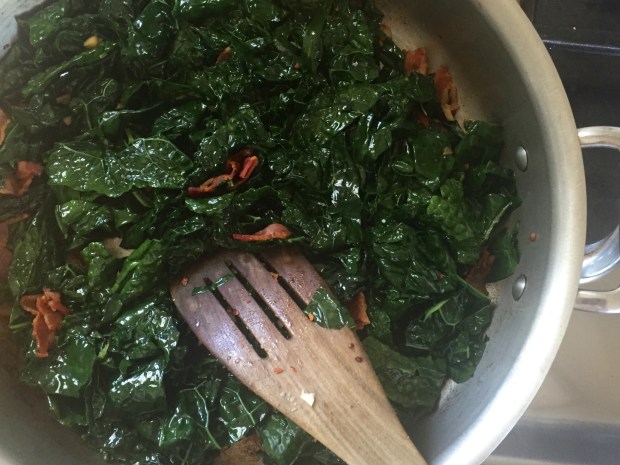
Stir-Fried Kale and Bacon
Serves: 8
Prep Time: 15 minutes
Cook Time: 15 minutes
Notes: There are lots of variations of this recipe floating around the Internet. This one is a bit faster, as I don’t think blanching the kale first is necessary. I also recommend using garlic and crushed red pepper flakes to give it an extra kick, and skipping the vinegar that some recipes recommend. That hides too much of the tasty bacon flavor. Also, keep in mind, this is a great dish if you’re working with limited oven space, as you can fry it up on the stovetop while the turkey rests. Lastly, like with the other dishes, cut up the kale earlier in the day, and pull it out when you’re ready to use it. So much less stressful!
Ingredients
- 4 bunches of Lacinto or Tuscan Kale (the regular stuff works fine too, in a pinch)
- 12 slices of uncooked bacon, cut into 1 inch pieces
- 4 garlic cloves, peeled and minced
- Kosher salt
- Crushed red pepper
Instructions
- Wash the kale, trim it of its stems (including the part that runs up the center between the leaves), then cut the leaves into wide ribbons, about an inch thick. Set aside until ready to use.
- Fry bacon over medium heat in a large frying pan until almost (but not quite) crisp.
- Remove some of the grease from the pan, making sure to leave about 4 Tablespoons worth (along with the bacon) in the frying pan.
- Add garlic, and cook with bacon for 30 seconds or so.
- Slowly begin adding kale to the pan. You won’t be able to fit it all in at once, but as the leaves start to wilt, keep adding more until it’s all in there.
- Add two healthy pinches of salt (a scant .5 teaspoon) and a good sprinkling of crushed red pepper (.25 to .5 teaspoon).
- Cook for 4-6 minutes, or until the leaves have all wilted and are tender to the bite. Serve immediately.
You Might Also Like
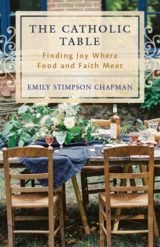
Every one of us has to eat. Some of us eat too much food. Or we eat too little. Sometimes we eat without gratitude, without charity, or without respect. But, as award-winning author Emily Stimpson Chapman explains in The Catholic Table, with a sacramental worldview, the supernatural gift of God’s grace can transform and heal us through the food we make, eat, and share.